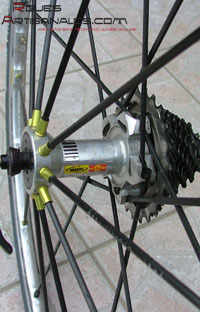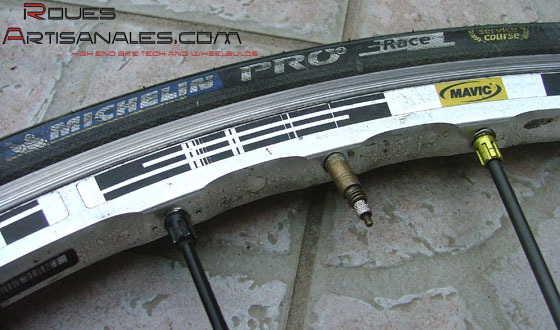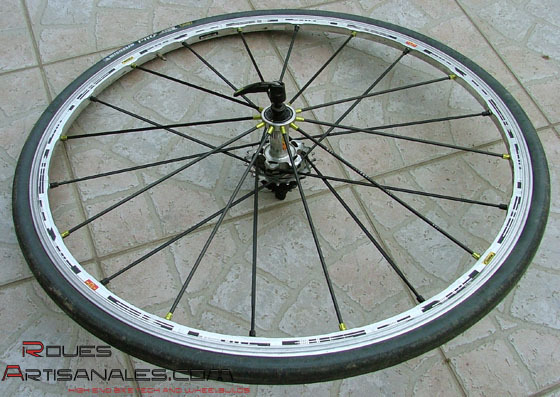|

The Mavic R-SYS wheelset has received a lot of media attention since their release. The well received TraComp system delivers weight saving and stiffness thanks to two critical points.
First, the very stiff carbon spokes are under very low tensioned and allow light rims.
Second, the wheels have been designed to hold the ends of the spokes firmly, through a ring in the hub and the thread in the rim. This is what theoretically makes them so stiff. We won’t go
repeat all the details here, but if you want to know more, you can read all the specifications in this article, we published at the end of June ’07, a couple of days after they were announced
So 7,000km later, what do we think about these wheels in terms of reliability and ride quality?
Although we have never really fussed over the products of the big wheel manufacturer (yes, yes we admit it!), we have to acknowledge these are pretty good, though with a few points for
improvement. Listen up Mavic R&D!
On the road, observations…
First of all, the R-SYS are quite light for a clincher wheelset. Claimed to be 1355g, they are obviously a little heavier at 1390g. We are still in the light weight range and this can
be felt on the road, both during accelerations and in uphills. However, our location in North France does not allow easy access to big mountains. We ride mostly on the flat with some steep
but short uphills (never more than 1km). You definitely noticed that the R-SYS are the only alloy wheels that entered the first group in our great wheel test (here). This is not trivial and they are quite comfortable with
some quite light tires (Michelin Pro 2 Race) and Michelin latex tubes.

In short, having trained hard with these wheels all winter and the end of last year, we noticed the following points:
- The front wheel makes some metallic noise while standing on the bike, it does not really like the rough roads, this is quite annoying… We understand Mavic have made some changes and
it seems more recent production runs do not suffer this problem.
- Excellent reliability, we didn’t have a single problem in 7,000km.
-
- Although the stiffness is claimed to be very high, we didn’t really feel it on the road. This was specially the case during the strong accelerations: the rim was still moving left and
right between the brake pads, which is probably not the epitome of stiffness… but it might mean the contrary. Is the load on the rim, coming from the ground, entirely passed to the
opposite side, to know between the brake pads, showing the high stiffness? Is the rim deflection due to the torque transfer, which is different for the two flanges of the hub, as we
explained in the review of the Lew Racing Pro VT1, strangely very stiff thanks to their central flange transfering all
the torque? That is hard to say, but we think about this last version. By the way, the next part of our great wheel test is taking longer than expected because of these observations. Tour
didn’t seem so rigorous in considering this parameter. The more we study the overall wheel stiffness, the least lateral stiffness seems important for wheel performance…
-
- The bearings were tight to start with but are now pretty smooth.
-
- The braking performance is still as good. The machined braking tracks work very well!
-
- The light silver glossy « engraved » letters on one carbon spoke of each wheel tend to disappear.
-
- Although this is totally imperceptible while riding, the front R-SYS is a veritable parachute compared to slimmer spoked wheels! (see the aero test)
Conclusion
We’ve told you everything you need to know about the R-SYS. They still have some teething faults but we enjoyed riding them. Ideally, they are best used for the mountains, when light
weight and low inertia count, and when aerodynamic properties of the wheel do not matter so much. But they aren’t confined to the most aggressive terrain: they will also do well in
races/rides when we expect a lot of kilometers at pace before attacking in the final uphill.
Anyway, do not use them during real high speed rides. You will be slowed down too much!

What would need to be improved ?
Basically, the R-SYS would be far better with the following two improvements:
- The front spokes could be slimmer and bladed: aerodynamics would be far better. However, stiffness will be lower (since the cross section is reduced), but who needs a super-stiff
front wheel…?
- Another colour option might look bolder than the silver/gold/black that isn’t a good match for many bikes
|



